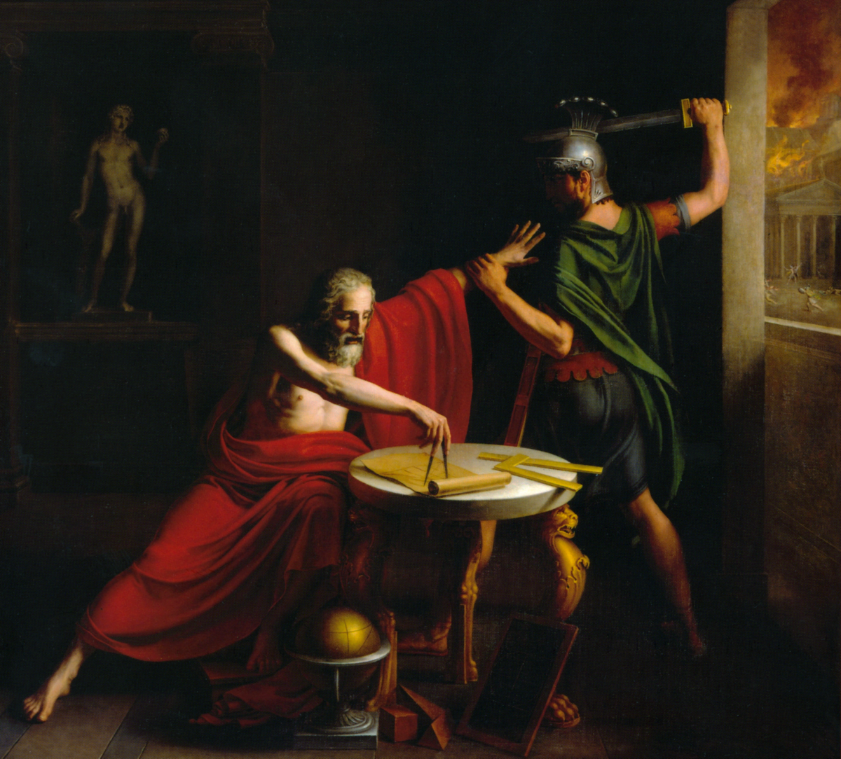Mathematics reveals its secrets only to those who approach it with pure love, for its own beauty. Archimedes
Archimedes wore many proverbial hats including that of a scientist, physician, mathematician, astronomer, inventor, and engineer. With so many titles to his name, it's a no-brainer that Archimedes also made a strong contribution to mathematics.
Aside from mathematics, Archimedes made great discoveries in the field of science too. In fact, Archimedes is the man known for running down the streets of Syracuse naked shouting, "Eureka, Eureka!" Eureka is a phrase that has come to be known as one that someone cries out when he or she has discovered something.
However, Archimedes did not only make one core discovery, but many discoveries that led his name to appear over and over again in both the mathematics and science fields. In fact, Archimedes of Syracuse, is known for having used maths or mathematical principles in order to explain the mechanics of daily life.
Archimedes goes down as a famous mathematician who contributed profoundly to maths as we know it today, alongside other mathematicians such as: Newton, Pythagoras, Thales, Descartes, and Einstein. If you are interested in learning about all the mathematicians who made an impact in the field of maths and science, you can do some reading on some of the great mathematicians in the history of the world of mathematics.
So, where did Archimedes stand in the world of mathematics? Continue reading to find out what Archimedes contribution to mathematics was all about.

More About Archimedes of Syracuse
There is not much background information known of Archimedes, but what is clear is that he was from Sicily in Italy. He did spend some time in Egypt very early on in his career, however, the bulk of his time was spent in Syracuse. What seems to be known is that Archimedes was born in Syracuse in 287 BCE. Archimedes had an astronomer father, and it is no wonder why Archimedes began to take a keen interest in and study sciences from a young age. Although there is not much else known about Archimedes, it has been documented that he managed to continue his studies at the reputable School of Alexandria.

While it does seem like it was all smooth sailing for this astronomer, physicist, scientist, mathematician, and engineer, this isn't at all the case. According to authors after Archimedes, he had written many works that never survived.
We can conclude that Archimedes from Syracuse had many Eureka moments, but he also had moments that did not allow him to scream and shout, "Eureka!"
What we know about Archimedes' Eureka moments is that Archimedes did make a contribution to the field of math, but how he documented his work is something that needs to be considered.
How exactly did Archimedes document his work?
Archimedes truly loved pure mathematics; however, it was the discovery of his unpublished works in the form of Archimedes Palimpsest that provides some evidence about how he came up with his mathematical theories, discoveries, and observations.
Archimedes can be seen in the same league as Pythagoras. Find out how Pythagoras made his mark by reading about the role Pythagoras played in the history of math.
Principles of Archimedes as Seen in Mathematics
Archimedes is credited with contributing to the advancements in both mathematics and the history of sciences. We will mainly focus on the contributions of Archimedes to Mathematics. It was Archimedes who has a feather in his cap for coming up with The Method of Exhaustion also known as the Archimedes method.
The Method of Exhaustion
Archimedes built upon the works of Eudoxus to create the Method of Exhaustion. Basically put, Archimedes came up with formulas for calculating areas of regular shapes. He was as such responsible for using a revolutionary method in order to view new shapes by working with shapes that he already knew well. Speaking about the Method of Exhaustion being used to calculate the area of regular shapes, we can also use this Method of Exhaustion to calculate the area found just under a parabola. It is the Method of Exhaustion that inevitably allowed him to expand even further on his reflections of shapes and calculating areas that were not initially considered. In fact, Archimedes even calculate the Number of Pi closest to its exact value. So, when you are calculating area for regular polygons, you have Archimedes to thank. The man who found the relationship between the perimeter of a circle and its diameter has created quite the stir in mathematics as we know it today.
If numbers have started to stir around in your head and you cannot seem to understand what perimeter means or how to distinguish between perimeter and area, we suggest that you search for a mathematics teacher in your area.
Reaching out to a mathematics tutor near you is possibly the best way to get to understand the maths jargon that sometimes floats overhead.

The Spiral of Archimedes
Being fixated with regular polygons, circles, and spirals as well, Archimedes studied the composition of the spiral. It took the philosopher and scientist much calculation time to deduce that the area of the spiral is equivalent to the radius of the circle that continued it. Based on this observation, Archimedes used the tangent to establish an equation of the circle.
For Archimedes, the mathematical formulas and calculations didn't stop there. Archimedes also worked on finding formulas for volume. For Archimedes, it was essential to calculate the areas and volumes of different objects. To calculate the areas and volumes of different objects, Archimedes applied all of his knowledge of mechanics to math.
This scientist became so fixated with the study of the areas and volumes of the sphere and the cylinder that Archimedes asked for the figures to be inscribed onto his gravestone.
While Archimedes does have these numerals depicted on his gravestone, the numbers he has discovered still has an impact on us today. Well, high school Mathematics students either celebrate Archimedes or sigh at the thought of how complex he has made math.
High school students will also be interested in discovering which other scientists and mathematicians came up with other great math ideas.
Law of Archimedes
Archimedes law of buoyance is one of the most celebrated discoveries ever. The law of buoyance is believed to be the treaty of floating bodies whereby it can be stated that anybody either completely or even partially submerged in fluid is acted upon upward by a force or Boyance. To explain this law, Archimedes noted the behaviour of solids that were submerged in fluid or gas. This is when Archimedes came up with the flotation principle which states that a force is applied on a solid body by gravity when the solid body is submerged in either a liquid or gas. Exploring the force even further, it was found that the pressure applied on the solid body is physically stronger at the base of the submerged body than on the top, which causes the body to float because of this uneven force.
Archimedes went a step further to prove this principle by experimenting with cylindrical objects. While the law of buoyance seems like a mere observation while taking a bath, this law of Archimedes is still applied in mechanics today.
Given the importance of a strong foundation in mathematics for academic and future career success, it might be beneficial to hire an online math tutor. An experienced tutor can offer personalized instruction, tailored to individual learning styles and needs, which can greatly enhance understanding of complex concepts, improve problem-solving skills, and boost overall confidence in the subject. This tailored support can make a significant difference in achieving academic goals and building a solid math foundation
One Main Invention of Archimedes
You are already aware that Archimedes wore many proverbial hats, and upon exploring all of Archimedes laws, theories, and mathematical observations, it is clear that he wore his title as a scientist and mathematician proudly. However, Archimedes was also seen as an inventor and he has invented many creations that he can be highly proud of.

Looking at Archimedes' background in mechanics, it is evident that he took a keen interest in studying the function of machines. In fact, one of his best creations that he still known for today is the Archimedes screw. While the thought of an Archimedes screw doesn't seem all that grand, this screw that was invented by Archimedes was actually used to pump water up against the force of gravity.
So, contrary to what you believe the screw may look like, the Archimedes screw is actually quite a large screw.
The other invention that Archimedes is rather famous for is the heat rays. The heat rays were used to make ships catch on fire and thus sink them. While this sounds like an invention that was meant to do more harm than good, the invention was actually created during the siege of Syracuse.
The last invention that Archimedes is well-known for is the ship breaking claw created specifically to break the ships of the enemies who were attacking Syracuse.
Undeniably, Archimedes is a scientist, mathematician and inventor whose footsteps you would really want to follow in. However, in order to make mathematical and scientific discoveries, you ought to love both mathematics and science.
If you are struggling with mathematics or science, reach out to one of our Superprof tutors today. One of our tutors can turn the frowns that you show when tackling these subjects upside down.
There are things that seem incredible to most men who have not studied mathematics. Archimedes
So, if you study mathematics, perhaps what seems incredible to others may not seem so incredible to you. Mathematics gives you a view of the world that you want to get to know!















